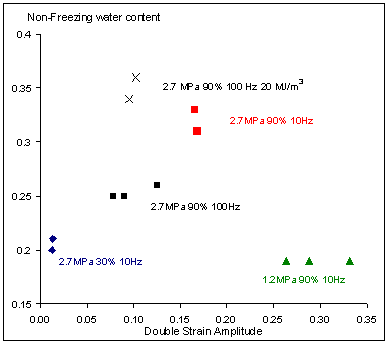
Prof. Petri P. Kärenlampi
Energy-Efficient Mechanical Pulping
Why should one investigate this?
Some 35 million tons of mechanical wood pulp are
produced
annually in the world. Any ton requiring some 2 MWh (7 GJ) of
electrical energy, the annual energy consumption is some 2.5 * 1017
J.
The annual electrical energy expense is about two billion Euros.
The energy consumption is far,
far too high.
The pulping processes have not been engineered based
on understanding of the physics of such processes; they have
rather evolved through trials and errors.
Thus it appears rather feasible to significantly improve the
energy
efficiency of such processes. For example, doubling the energy
efficiency will create annual savings (or increased profits)
worth a billion
Euros.
Internal
Fibrillation
It is not difficult to separate fibers from each other.
However, rapidly separated fibers tend to be stiff,
and not very useful for most practical purposes.
An essential element in successful pulping is Internal
Fibrillation.
This means loosening of the cell wall structure in a way which
makes the fibers more flexible. This can be achieved through
mechanical treatment.
How could one achieve internal fibrillation effectively?
This is not an easy question to answer.
Fatigue processes in general are poorly understood.
Anyway, there are classical approaches:
- low-cycle fatigue approaches discuss fatigue damage in terms of
stress amplitudes
- high-cycle fatigue approaches discuss fatigue damage in terms
of plastic strain amplitudes.
Molecular Fatigue
in Wood
We have loaded wood specimens in saturated water
steam conditions at 130° C, using a servohydraulic testing
machine. The dynamic loading result has been characterized
in terms of change of porosity in the cell walls, particularly
in the Non-Freezing
Water Content.
The Figure below shows the NFW
Content of earlywood as a function
of applied double strain amplitude. The experiments have been
conducted in circumstances of uniaxial compressive strain in the
tangential
material direction. The text in the Figure shows the applied peak
compressive
stress, the double stress amplitude in relation to the peak
stress
(relative double stress amplitude) as well as the loading
frequency.
All the specimens have been loaded using a mechanical
energy input of 10 MJ/m3, which corresponds to 0.5% of
the
energy application of a commercial process.

We find from the above Figure
that the increment in the NFW content
is apparently linearly proportional to the applied strain
amplitude,
as long as a compressive peak stress of 2.7 MPa is used.
A compressive peak stress of 1.2 MPa induces a very large
strain amplitude, but no molecular reorganization.
The above can be explained in terms of the high-cycle fatigue
approach. The fatigue damage is likely to develop in the course
of loading cycles as a function of plastic
strain amplitude.
The smaller applied stress level does not appear to induce
significant reversed plasticity.
We further find from the above Figure that different methods in
changing the strain amplitude do change the molecular reaction
in a way which appears to fit the same linear relationship
between
strain amplitude and NFW content.
The strain amplitude may become reduced either by reducing the
relative double stress amplitude from 90% to 30%, or by
increasing
the loading frequency from 10 Hz to 100 Hz.
The latter result may appear to be problematical.
The decrement of strain amplitude naturally is due to
the time-dependency of material stiffness. Thus high
strain amplitude generally requires a low straining
rate. However, slow processes have a low production rate,
and therefore they are very expensive when applied in the
industry.
In other words, a process with a low production rate
has a high capital demand.
No worries.
Let us apply the high-rate 100 Hz process with
an energy input of 20 MJ/m3, and see what happens.
We find from the Figure below that such an extended
treatment results as a significant reorganization in the
cell walls. Such a process takes only four seconds, and
still consumes less than 1% of the electrical energy
consumption of a traditional commercial process.

How could we apply the above results?
Clearly, a mechanical pulping process could be made
much more effective.
However, in a capital-intensive industry, any producer
is very careful in applying new technology.
Any new technology should be proven in extended laboratory
experiments, followed by pilot-scale arrangements.
In particular, the above results should be reproduced in an
arrangement which does not only induce molecular reorganization
within a cell wall, but also produces a pulp slurry. Amazingly, that
has not been too difficult, even if rather laborious in the experimental
sense. We find from below that the specific energy consumption has
so far been reduced by 30%, whereas optical and mechanical properties
have remained.


We will be happy to tell you more if you give
us a lot of money.
The experimental arrangement is illustrated below.
